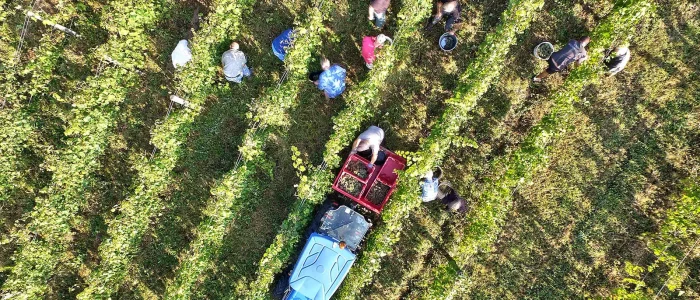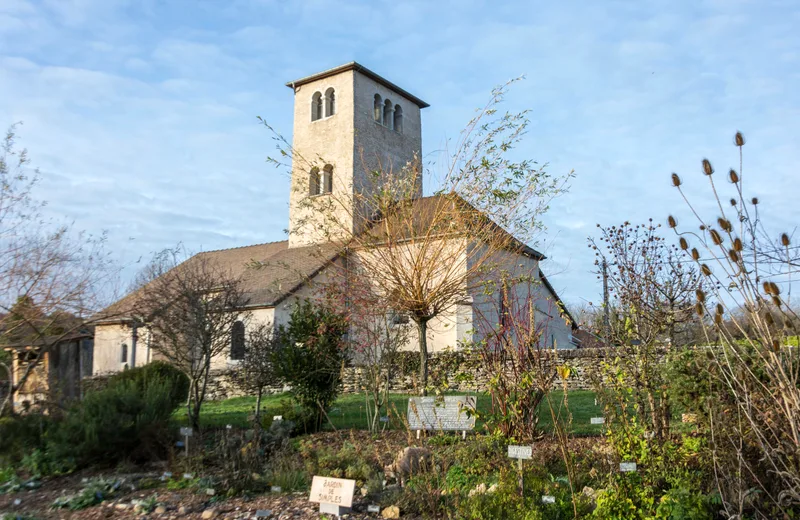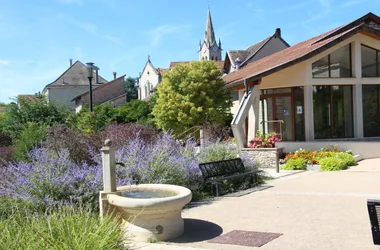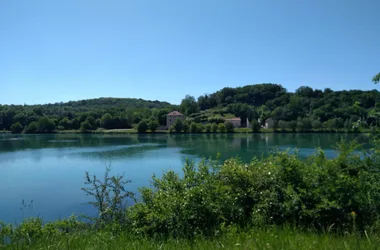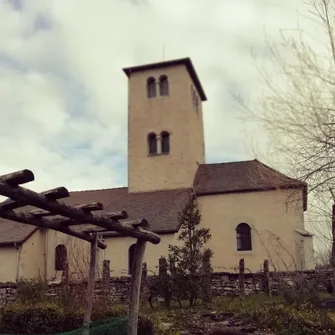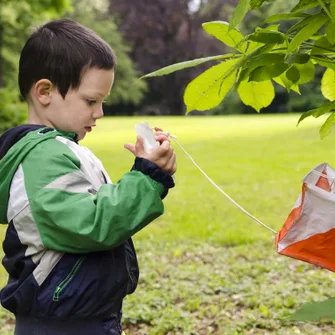Porcieu-Amblagnieu
Welcome to Porcieu-Amblagnieu located to the north-east of the Balcons du Dauphiné. Come and discover the church of Amblagnieu and its simple garden, the church of Porcieu and the vernacular heritage which testifies to the importance of stone for the village.
We find in Porcieu-Amblagnieu the traces of a distant past, on the one hand by the Roman site of La Serre discovered during the construction of the feed canal of the Villebois dam, on the other hand by the discovery, in a limestone landslide, objects (axes and hammers with sockets, daggers with rivets) dating from the Middle Bronze Age, almost to the transition to the Final Bronze Age.
1. La pierre and Porcieu-Amblagnieu
Porcieu-Amblagnieu stone, a precious limestone, played a key role in the local economy since the 19th century.
If initially the exploitation of this stone was used locally for the construction of public and private buildings, its exploitation quickly experienced strong growth around 1820. It is widely used in regional construction and in major construction projects in France and in Swiss. So much so that there were 20 companies linked to this activity and 50 quarries in the town during the XNUMXth century.
This growth even transformed the village, because if until then the economic center was in Amblagnieu, we observed a transfer of attractiveness towards Porcieu which became a commune in 1878, the date on which the village took the name “Porcieu-Amblagnieu”.
Between 1884 and 1957, the town was the terminus of the Eastern Lyon railway, serving in particular the Porcieu quarry.
Ultimately, this economy experienced decline in particular because of the Second World War, but also European competition and new technologies which required considerable adaptations from businesses.
Today, only 3 companies continue to exploit this stone in this village.
We find various witnesses to the importance of the stone in the town:
– Careers: those that are abandoned, but also those still active.
– Plant stones: erected vertically and planted a third apart, they demarcate fields and paths.
– Dry stone fence walls: also serving as a boundary.
– Marinières: these are piles of stones rejected by quarries.
– Bigues: these are stone posts used for growing vines.
– The bachats: these stone constructions were once used as watering troughs, they are today reused as flower boxes.
– The suets: also called threshing floors, they allowed farmers to thresh grain using smooth rock.
– Stone buildings: such as the town hall, the primary school, the village houses.
2. The heritage of Porcieu-Amblagnieu
– The Amblagnieu church and the Jardin des Simples: In the heart of Amblagnieu, it is made up of a nave, a choir and 5 chapels: 3 on the north side and 2 on the south side. The bell tower is a square tower pierced with twin bays (window divided into two equal parts generally vertical, most often by means of a column).
A medallion allows us to read “Saint-André and Saint-Laurent 1510”, indicating the saints to whom the building was dedicated, but perhaps also the date of a reconstruction or renovation of the church.
The latter was gradually abandoned during the 19th and 20th centuries in favor of the new church built in Porcieu, the new center of activity in the commune.
The church was bought in 1993 by the association “Les Amis de l'église d'Amblagnieu” to restore it and preserve its function. In 2003, the town hall became the owner of the building.
In 2009, a “simple garden” was created. Maintained by volunteers, it presents more than 100 medicinal plants used in the popular pharmacopoeia, classified according to their properties (tonic, digestive, febrifuge, etc.). This historic garden is enriched with aromatic plants and ancient species, and recalls the importance of natural remedies in local culture. In 2010, the frescoes inside the church were restored.
– The church of Porcieu: its construction follows the demographic and economic evolution of Porcieu, it was completed in 1867. In a neo-Gothic style, it is recognized for its original aesthetic and its slender spire, dedicated mainly to Saint-André while by honoring Saint-Clair, the patron saint of stonecutters.
– The church of Vassieu: known as Saint-Denys, it was in ruins in 1654. Despite the lack of means, a priest continued to say mass until the end of the XNUMXth century; today, only two statuettes of Saint-Rémi and Saint-Denis remain of the building.
– Turnoud Castle (private site): built in a neo-Renaissance style in the 1993th century in cut stone, it succeeds another castle made of wood and earth dating from before the year XNUMX. It was renovated in XNUMX by its owner.
– Fortified houses (private sites): the fortified houses of Conilieu and Marieu date from the 14th century.
– The fortified house of Conilieu: located high up, this 16 meter high building had a dominant position over the hamlet. Founded by the Ameyssin family, this fortified house grew and enjoyed a certain prosperity until the Revolution. It was sold as a “National Property” during the Revolution, a time when the estate was divided up and the castle demolished by its buyers since it was even used as a stone quarry. Today, only one building remains.
– Of the Marieu fortified house, called “Château Servant”, only a rectangular building remains, largely pierced by mullioned windows and completed to the south by a large circular tower.
– Vernacular heritage: discover the 4 wash houses, the 2 wells and the 2 flywheel pumps of Porcieu-Amblagnieu.
3. Porcieu-Amblagnieu and the Rhône:
– River navigation: Porcieu-Amblagnieu was a place of passage since Antiquity for the numerous goods transported to and from the Mediterranean and the major urban centers. The commune was part of the Lyon-Seyssel portion. The descent of the river took between 2 and 3 days, but the return via the towpaths required, in addition to resources, a considerable amount of time, between 15 and 17 days. This is why only valuable goods went up the river, otherwise the boats were generally destroyed in Seyssel and the wood was recovered to be used for other purposes such as heating. The journey was greatly facilitated in 1837 with the Abeille, a steamboat which went up the river for the first time in this part of its course. In the summer of 1860, a daily connection was set up between Lyon and Aix-les-Bains. Gradually this mode of communication disappeared in favor of the use of the train at the end of the XNUMXth century.
– The hydroelectric plant built on the Rhône by the CNR (Compagnie nationale du Rhône) made it possible to find another use for the Rhône, thus developing another economy linked to energy but also to sports leisure activities with the creation of the artificial river from Isle de la Serre.
– ViaRhona: take advantage of this paved cycle route to stroll along the Rhône!
4. Leisure activities in Porcieu-Amblagnieu*
- Spectacular ! The Anim'Loisirs association energizes local life with a rich cultural program.
-Refreshing! The Isle de la Serre whitewater area offers a multitude of activities: rafting, hydrospeed, canoraft, canyoning…
* To find out more, contact the Balcons du Dauphiné Tourist Office.
1. La pierre and Porcieu-Amblagnieu
Porcieu-Amblagnieu stone, a precious limestone, played a key role in the local economy since the 19th century.
If initially the exploitation of this stone was used locally for the construction of public and private buildings, its exploitation quickly experienced strong growth around 1820. It is widely used in regional construction and in major construction projects in France and in Swiss. So much so that there were 20 companies linked to this activity and 50 quarries in the town during the XNUMXth century.
This growth even transformed the village, because if until then the economic center was in Amblagnieu, we observed a transfer of attractiveness towards Porcieu which became a commune in 1878, the date on which the village took the name “Porcieu-Amblagnieu”.
Between 1884 and 1957, the town was the terminus of the Eastern Lyon railway, serving in particular the Porcieu quarry.
Ultimately, this economy experienced decline in particular because of the Second World War, but also European competition and new technologies which required considerable adaptations from businesses.
Today, only 3 companies continue to exploit this stone in this village.
We find various witnesses to the importance of the stone in the town:
– Careers: those that are abandoned, but also those still active.
– Plant stones: erected vertically and planted a third apart, they demarcate fields and paths.
– Dry stone fence walls: also serving as a boundary.
– Marinières: these are piles of stones rejected by quarries.
– Bigues: these are stone posts used for growing vines.
– The bachats: these stone constructions were once used as watering troughs, they are today reused as flower boxes.
– The suets: also called threshing floors, they allowed farmers to thresh grain using smooth rock.
– Stone buildings: such as the town hall, the primary school, the village houses.
2. The heritage of Porcieu-Amblagnieu
– The Amblagnieu church and the Jardin des Simples: In the heart of Amblagnieu, it is made up of a nave, a choir and 5 chapels: 3 on the north side and 2 on the south side. The bell tower is a square tower pierced with twin bays (window divided into two equal parts generally vertical, most often by means of a column).
A medallion allows us to read “Saint-André and Saint-Laurent 1510”, indicating the saints to whom the building was dedicated, but perhaps also the date of a reconstruction or renovation of the church.
The latter was gradually abandoned during the 19th and 20th centuries in favor of the new church built in Porcieu, the new center of activity in the commune.
The church was bought in 1993 by the association “Les Amis de l'église d'Amblagnieu” to restore it and preserve its function. In 2003, the town hall became the owner of the building.
In 2009, a “simple garden” was created. Maintained by volunteers, it presents more than 100 medicinal plants used in the popular pharmacopoeia, classified according to their properties (tonic, digestive, febrifuge, etc.). This historic garden is enriched with aromatic plants and ancient species, and recalls the importance of natural remedies in local culture. In 2010, the frescoes inside the church were restored.
– The church of Porcieu: its construction follows the demographic and economic evolution of Porcieu, it was completed in 1867. In a neo-Gothic style, it is recognized for its original aesthetic and its slender spire, dedicated mainly to Saint-André while by honoring Saint-Clair, the patron saint of stonecutters.
– The church of Vassieu: known as Saint-Denys, it was in ruins in 1654. Despite the lack of means, a priest continued to say mass until the end of the XNUMXth century; today, only two statuettes of Saint-Rémi and Saint-Denis remain of the building.
– Turnoud Castle (private site): built in a neo-Renaissance style in the 1993th century in cut stone, it succeeds another castle made of wood and earth dating from before the year XNUMX. It was renovated in XNUMX by its owner.
– Fortified houses (private sites): the fortified houses of Conilieu and Marieu date from the 14th century.
– The fortified house of Conilieu: located high up, this 16 meter high building had a dominant position over the hamlet. Founded by the Ameyssin family, this fortified house grew and enjoyed a certain prosperity until the Revolution. It was sold as a “National Property” during the Revolution, a time when the estate was divided up and the castle demolished by its buyers since it was even used as a stone quarry. Today, only one building remains.
– Of the Marieu fortified house, called “Château Servant”, only a rectangular building remains, largely pierced by mullioned windows and completed to the south by a large circular tower.
– Vernacular heritage: discover the 4 wash houses, the 2 wells and the 2 flywheel pumps of Porcieu-Amblagnieu.
3. Porcieu-Amblagnieu and the Rhône:
– River navigation: Porcieu-Amblagnieu was a place of passage since Antiquity for the numerous goods transported to and from the Mediterranean and the major urban centers. The commune was part of the Lyon-Seyssel portion. The descent of the river took between 2 and 3 days, but the return via the towpaths required, in addition to resources, a considerable amount of time, between 15 and 17 days. This is why only valuable goods went up the river, otherwise the boats were generally destroyed in Seyssel and the wood was recovered to be used for other purposes such as heating. The journey was greatly facilitated in 1837 with the Abeille, a steamboat which went up the river for the first time in this part of its course. In the summer of 1860, a daily connection was set up between Lyon and Aix-les-Bains. Gradually this mode of communication disappeared in favor of the use of the train at the end of the XNUMXth century.
– The hydroelectric plant built on the Rhône by the CNR (Compagnie nationale du Rhône) made it possible to find another use for the Rhône, thus developing another economy linked to energy but also to sports leisure activities with the creation of the artificial river from Isle de la Serre.
– ViaRhona: take advantage of this paved cycle route to stroll along the Rhône!
4. Leisure activities in Porcieu-Amblagnieu*
- Spectacular ! The Anim'Loisirs association energizes local life with a rich cultural program.
-Refreshing! The Isle de la Serre whitewater area offers a multitude of activities: rafting, hydrospeed, canoraft, canyoning…
* To find out more, contact the Balcons du Dauphiné Tourist Office.
Themes:
Visit
Individual visit services
- Unguided individual tours permanently
Opening
| Opening hours from January 01 to December 31, 2024 | |
|---|---|
| Monday | Open |
| Tuesday | Open |
| Wednesday | Open |
| Thursday | Open |
| Friday | Open |
| Saturday | Open |
| Sunday | Open |
Prices
Free access.
Services
Equipments
Linked offers
On the spot…
